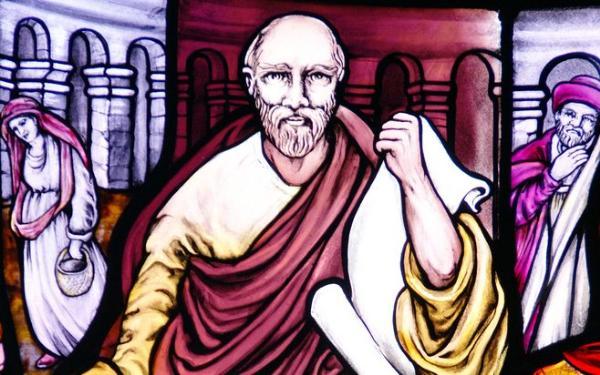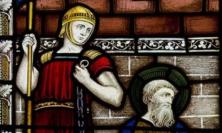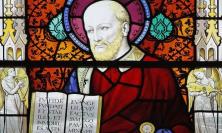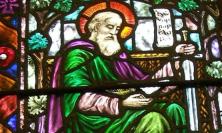Over the next three weekends, on Sundays 31-33 of Year C in the lectionary, we will hear Second Readings taken from Paul’s Second Letter to the Thessalonians. What do we know about the community to whom Paul was writing? Peter Edmonds SJ uses the Acts of the Apostles and the two letters that Paul wrote to the Thessalonians to introduce us to these early Christians who ‘received the word with joy inspired by the Holy Spirit’.
If you mention the Letters to the Thessalonians to anyone with even a slight acquaintance with Paul’s letters, they will almost certainly think immediately of the Second Coming of Christ and the Day of the Lord. This is a good reason why extracts from these letters are read as Second Readings at the close of two of our liturgical years: on five Sundays at the end of Year A in the Catholic Sunday lectionary; and on three Sundays at the end of Year C. (The actual last Sunday of each year, the Feast of Christ the King, has its own readings.)
It is appropriate, then, at this time of year when we visit Thessalonica in our liturgy, to familiarise ourselves with the life of this community of Christians who practised our faith when it was young. There are three brief texts from which we can learn about them, and they teach us that worries about the Last Days were just part of the picture. These texts are 13 verses from the Acts of the Apostles (Acts 17:1-13), the 89 verses (five chapters) of Paul’s First Letter to the Thessalonians and the 47 verses (three chapters) of Paul’s Second Letter to the Thessalonians.
The Acts of the Apostles (Acts 17:1-13)
The passage from Acts is taken from the part of Luke’s book that relates Paul’s progress down the Roman road named the Via Egnatia, which linked various cities in Greece. Paul, with Silas, has crossed from Asia into Europe. His first stay was in Philippi, where Acts is in agreement with Paul’s own report that there he was ‘given rough treatment and grossly insulted’ (Acts 16:11-39; 1 Thessalonians 2:2). His next stay was at Thessalonica. This was an ancient city, founded by a general of Alexander the Great whose ambition was to spread Greek culture and civilisation far and wide. A hundred years before Paul arrived, it had come under the rule of Rome. It was typical of the cities where Christian communities would flourish.
Jason of Thessalonica
As was his custom on arriving in a new city, Paul went straight to the Jewish synagogue. There, for three successive Sabbaths, he argued how the Scriptures spoke about the suffering and rising of Christ. He had limited success, but he certainly caused a stir. He became the victim of a riot: the Jews assembled a crowd to bring him before the city authorities, putting him in great danger by charging him with trying to acclaim Christ as emperor. His opponents seized one called Jason who seems to have given Paul lodging. Obviously Paul had allies because they packed him off to the next town, but the Jews of Thessalonica pursued him and, though his new mission in Beroea made progress, he soon moved on. Perhaps he remembered the instruction of Jesus to the Twelve to leave a town which did not welcome them (Luke 9:5).
This passage is never read out on a Sunday; the readings from Acts after Easter cease after the account of the Council of Jerusalem (15:1-2, 22-29). However, on the fourth Sunday of Easter in Year C, we hear from Paul’s sermon to the Jews in the synagogue at Antioch which gives us a good idea of how Paul would employ scripture in preaching before a Jewish audience (Acts 13:14,43-52).
Acts is dated around AD 85, which means that its author is recounting events of forty years before. The advantage of reading Paul’s First Letter to the Thessalonians, the earliest New Testament book, is that it was written soon after his missionary visit in 49. Paul was a busy man: his daily preoccupation was ‘his anxiety for all the churches’ (2 Corinthians 11:28). He probably wrote this letter during his eighteen month stay in Corinth (Acts 18:5).
Paul’s First Letter to the Thessalonians
Midway through the First Letter to the Thessalonians, Paul inserts a prayer which commentators recognise as a neat summary of the message he wanted to get across:
Now may our God and Father himself and our Lord Jesus direct our way to you. And may the Lord make you increase and abound in love for one another and for all, just as we abound in love for you. And may he so strengthen your hearts in holiness that you may be blameless before our God and Father at the coming of our Lord Jesus with all his saints. (1 Thessalonians 3:11-13).
He wrote as a substitute for visiting, to increase the quality of love in the community, to strengthen them in holiness (probably an appeal for sexual purity) and to prepare them for the coming of the Lord Jesus. We note other themes, too. His first chapter is an attractive description of the qualities expected of a Christian community; his aim was to win over their good will and to encourage them, and this was his way of doing this. Their Christian life had brought them affliction and he wanted to help them to endure it. He also needed to help them explain himself, his work and his identity to their fellow citizens; this was the topic of his second chapter.
An ideal community (1:1-10) – ‘Their love for one another and for all’
In the Sunday Lectionary, the first chapter is given in two instalments. On the 29th Sunday of Year A, we hear Paul’s greeting. He refers to his companions, Silvanus and Timothy. He describes those he addressed as a ‘church’, despite their small numbers and their youthfulness in the faith. He emphasises the qualities of the faith, love and hope that marked their commitment and, surprisingly at such an early date in the Christian story, he refers to members of the Trinity: he names God as the Father who loves, Jesus as their Lord, and the Holy Spirit as the force and inspiration of the gospel he preached (1:1-5).
On Sunday 30A, he continues his description of the quality of their life together. The Thessalonians were people of joy who, having imitated Paul, had become examples to other communities in Achaia (Greece). He acknowledges the tribulations that they had to face and he congratulates them on their perseverance. The early date of the letter is confirmed by a mention of their expectation of the imminent return of Christ. Presiding over the whole scene is God: the God of these Christians is not a god of idols but a God who is living and active (1:5-10).
There are striking contrasts with what we learnt from Acts. Paul’s converts here are obviously Gentile rather than Jewish because they have turned aside from idols, and Paul makes no obvious appeal to Scripture in his argument. His words presuppose a longer stay than the three weeks reported in Acts.
Paul defends himself (2:7-9, 13) – ‘We abound in love for you’
On Sunday 31A, we read verses from the second chapter of the letter. These are selected from Paul’s response to critics who were telling his converts that he had flattered and deceived them; that, like other wandering teachers of the time, he was a charlatan, out for their money and little else. In answer, Paul describes himself as an apostle of Christ; his care for them was that of a mother; he took great care to make no financial or other demands on them. His commitment was total; he regarded them as his brothers and sisters: theirs was truly a family of God. The gospel he preached was no personal invention, but came from God and derived its power from God. Paul speaks in the powerful tones of a defendant in a secular court. If in the first chapter of the letter, we are offered a model of a Christian community, in this second we gaze at a portrait of a devoted pastor.
Comfort one another (4:13-18) – ‘The coming of our Lord Jesus Christ’
On Sunday 32A, we hear the part of the letter that is best known, partly because it is frequently read at funeral Masses. Paul has heard about a particular problem that had come up in this community with its high expectations of an early return of Christ. They were concerned about their members who had died: would they miss out on this return? Paul’s habit was to approach pastoral problems theologically, and he does so here. He reminds his converts of his basic gospel: that ‘Jesus died and rose again’. What God had done for and with his Son, he would do for them, too. They too would share in the resurrection. This is the start of Paul’s argument. His conclusion is equally relevant: their destiny was to be with the Lord forever, and this was a truth they were to repeat for mutual comfort and encouragement.
If the beginning and end of Paul’s paragraph are easy to assimilate, the same is not true of its centre, because here Paul uses the language of apocalyptic, a way of speaking familiar in his time but not in ours. This is a poetic way of speaking which is not to be taken literally, as it often is by biblical fundamentalists. If we are to meet Christ after being taken up in the clouds, it means that we will share with Christ the same sort of heavenly journey which the apostles saw Jesus take on Ascension Day (Acts 1:9). In a modern scientific age, we do not take such language at its face value, but look for the theological truth that it expresses.
The Day of the Lord (5:1-6) – ‘Blameless before our God and Father’
Our final passage from the first letter on Sunday 33A is on a related topic, the ‘Day of the Lord’. This was a topic treated in prophets like Amos who warned that this would mean ‘darkness, not light’ (5:18). For Paul, this has become the Day of Christ, to be welcomed by his converts who were ‘children of light and children of the day’. The imagery was suggested by the visit of the Roman Emperor to a particular city, a day of joy and celebration. We note that Paul does not commit himself to any date. In this he echoes Jesus in the gospel who tells his disciples that only the Father knows the date of ‘that day or that hour’ (Mark 13:32). He also echoes gospel language in speaking of a thief in the night (Matthew 24:43-44).
The Second Letter to the Thessalonians
As well as being much shorter than the First Letter to the Thessalonians, the Second Letter is less personal. The writer is a more distant figure; the style is more formal, the tone more authoritarian. Most Pauline experts date the letter much later, perhaps of similar vintage to the Letters to Timothy and Titus. They recognise a writer appealing to the authority of Paul years later.
The letter deals with three major topics. The first chapter concentrates on the persecution that the community was enduring. The second chapter instructs about the Second Coming of Christ. This is nothing to be excited about; certain events must occur before it happens, and these things have not happened. The third chapter concentrates on moral behaviour, warning in particular against the dangers of idleness.
The Sunday lectionary provides one passage from each chapter for the Second Readings of the three last Sundays of the entire three year cycle, but they are brief. We only hear 17 of the 47 verses of the letter and some would argue that, in their brevity, these do not include the liveliest and most interesting.
A first prayer (1:11-2:2) – ‘Worthy of your call’
Our first extract on Sunday 31C falls into two parts. The first is an attractive prayer which we can make our own. Its tone is very different from the verses that go before it, which contain some of the fiercest words in Pauline literature; they threaten eternal loss to all who fail to acknowledge God and the gospel of Christ. Its second part introduces an account of the signs which will mark the second coming of Christ. Its message is gentle, telling us not to be alarmed about these events; again this contrasts with the dramatic description that follows of what will happen before Christ comes again.
More prayers (2:16-3:5) – ‘Pray for us’
Our second extract, on Sunday 32C, has prayer as a key word. It begins and ends with a petition to the Lord Jesus Christ as well as God the Father for comfort and strength, that the hearers may turn their hearts towards the love of God and the fortitude of Christ. They were to keep the traditions they have been taught. Enclosed by these prayers is an appeal for prayer for Paul and his mission. Such prayer is to be confident because it is directed to a Lord who is faithful. The ‘bigoted and evil people’, so prominent at the beginning of the letter, are hardly mentioned.
Daily living (3:7-12) – ‘We worked night and day’
The passage appointed for Sunday 33C indicates practical problems that arose in early Christian communities. Paul appeals to his own example of working day and night in order that he should be no burden on them. It could be that certain leaders, and others in the community, were idle and expecting other church members to take care of them. The prayers quoted in previous passages from this letter should have ensured that everybody got on quietly with their work and earned their keep. In these final lines, Paul uses unusually strong language of command; he much prefers to request than to order. The whole passage is bracketed by the words, ‘Our Lord Jesus Christ’, words that also occur in the first and last verses of the letter.
The Church at Thessalonica continues to this day in Thessaloniki, the second city of modern Greece; the letters that Paul wrote to their predecessors in the faith live on in our Bibles and our liturgies. Paul wrote, ‘My orders, in the Lord’s name, are that this letter be read to all the brothers and sisters’ (1 Thessalonians 5:27). His hearers heeded this order and kept the letter for posterity, so that Paul’s praise for their ‘work of faith, labour of love and steadfastness of hope in our Lord Jesus Christ’ (1 Thessalonians 1:3) was not forgotten. May we become imitators of them, as they became imitators of Paul and the Lord (1 Thessalonians 1:6).
Peter Edmonds SJ is a member of the Jesuit community in Stamford Hill, north London.
More articles on the Letters of Saint Paul on Thinking Faith:
![]() ‘The Letter to the Colossians’ by Brian Purfield
‘The Letter to the Colossians’ by Brian Purfield![]() ‘The Letter of Paul to the Philippians’ by Peter Edmonds SJ
‘The Letter of Paul to the Philippians’ by Peter Edmonds SJ
![]() ‘The Letters to Timothy and Titus’ by Peter Edmonds SJ
‘The Letters to Timothy and Titus’ by Peter Edmonds SJ






